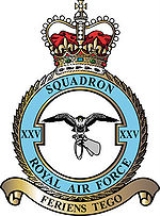
No. XXV Squadron RAF
Overview
Squadron (aviation)
A squadron in air force, army aviation or naval aviation is mainly a unit comprising a number of military aircraft, usually of the same type, typically with 12 to 24 aircraft, sometimes divided into three or four flights, depending on aircraft type and air force...
of the Royal Air Force
Royal Air Force
The Royal Air Force is the aerial warfare service branch of the British Armed Forces. Formed on 1 April 1918, it is the oldest independent air force in the world...
. Until April 2008 the squadron operated the Panavia Tornado
Panavia Tornado
The Panavia Tornado is a family of twin-engine, variable-sweep wing combat aircraft, which was jointly developed and manufactured by the United Kingdom, West Germany and Italy...
F3, from RAF Leeming
RAF Leeming
RAF Leeming is a Royal Air Force station in North Yorkshire, UK.HRH The Duchess of Cornwall is the Honorary Air Commodore of RAF Leeming. The Station Commander is Group Captain Anthony Innes....
.
No. 25 Squadron RAF was formed at RAF Montrose
RAF Montrose
RAF Montrose was a Royal Air Force station in Forfarshire in Scotland.In 1912, the British government planned twelve "Air Stations" operated by the Royal Flying Corps...
on 25 September 1915 from No. 6 Reserve Squadron, moving to France in February 1916, flying F.E.2bs
Royal Aircraft Factory F.E.2
The Royal Aircraft Factory F.E.2 was a two-seat pusher biplane that was operated as a day and night bomber and as a fighter aircraft by the Royal Flying Corps during the First World War...
on fighter and reconnaissance duties. They gave way to D.H.4 bombers in 1917.
During the course of the First World War, 25 Squadron had nine flying aces among its ranks, including
James Fitz-Morris,
James Green
James Green (aviator)
Sergeant James Hubert Ronald Green was a World War I flying ace credited with six aerial victories.-Reference:...
,
Reginald George Malcolm
Reginald George Malcolm
Captain Reginald George Malcolm was a Canadian flying ace during World War I. He was credited with eight aerial victories scored during March, April, and May 1916.-Early life:...
,
Lancelot Richardson
Lancelot Richardson
Captain Lancelot Lytton Richardson was an Australian flying ace during World War I. He was credited with seven confirmed aerial victories.-Early life and service:...
,
Noel Webb
Noel Webb (aviator)
Captain Noel William Ward Webb was an early World War I flying ace credited with 14 aerial victories. He was the first pilot to use the Sopwith Camel to claim an enemy plane...
,
Charles Woollven
Charles Woollven
Captain Charles Henry Chapman Woollven was a World War I flying ace credited with five aerial victories.Woollven was seconded from the Devon Regiment to the Royal Flying Corps. On 19 June 1916, he joined 25 Squadron as a pilot assigned to a Royal Aircraft Factory FE.2. He scored his first victory...
Alexander Roulstone
Alexander Roulstone
Captain Alexander Roulstone was a World War I flying ace credited with eight aerial victories. He scored his victories, and downed two German aces, while handicapped by flying bombers.-World War I service:...
,
Leonard Herbert Emsden
Leonard Herbert Emsden
Sergeant Leonard Herbert Emsden DCM was an observer and gunner aboard Royal Aircraft Factory FE.2b two-seater airplanes. He began scoring aerial victories during March 1917, continued winning through Bloody April, and capped his career as a flying ace with three victories on 1 May 1917...
, and
Hartley Pullan
Hartley Pullan
Lieutenant Hartley Pullan DFC was a World War I flying ace credited with five aerial victories.-References:...
.
After the war the squadron acquired D.H.9s
Airco DH.9
The Airco DH.9 - also known after 1920 as the de Havilland DH.9 - was a British bomber used in the First World War...
.
Unanswered Questions

